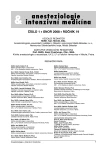Neuromonitoring of brain injury patients
Authors:
R. Pařízková
Authors‘ workplace:
Klinika anesteziologie, resuscitace a intenzivní medicíny Univerzity Karlovy v Praze, Lékařské fakulty v Hradci Králové a Fakultní nemocnice Hradec Králové
Published in:
Anest. intenziv. Med., 19, 2008, č. 1, s. 32-36
Category:
Intensive Medicine
Overview
Monitoring traumatic brain injury represents an integral part of the intensive care of severely brain injured patients. Special methods for neuromonitoring allow the detection and treatment of early secondary ischaemic insults associated with worse outcome. This review article covers the current views of brain tissue oxygen monitoring used in clinical practice.
Keywords:
brain injury – neuromonitoring – tissue oxygenation
Sources
1. Anonymous Consensus Conference. Rehabilitation of persons with traumatic brain injury. NIH Consensus Development Panel on Rehabilitation of Persons With Traumatic Brain Injury. JAMA, 1999, 282, p. 974–983.
2. Brain Trauma Foundation. Guidelines for the Management of Severe Traumatic Brain Injury. J. Neurotrauma, 2007, 24 (Suppl. 1), p. S1–S95.
3. Bhatia, A., Gupta, A. K. Neuromonitoring in the intensive care unit. II. Cerebral oxygenation monitoring and microdialysis. Intensive Care Med., 2007, 33, p. 1322–1328.
4. Wendy, L. W. Multimodal monitoring in the ICU: When could it be useful? J. Neurological Sci., 2007, 26, p. 10–15.
5. Bhatia, A., Gupta, A. K. Neuromonitoring in the intensive care unit. I. Intracranial pressure and cerebral blood flow monitoring. Intensive Care Med., 2007, 33, p. 1263–1271.
6. Tisdall, M. M., Smith, M. Multimodal monitoring in traumatic brain injury: current status and future directions. B. J. A., 2007, 99, 1, p. 61–67.
7. Zauner, A., Daugherty, W. P., Bullock, M. R., Warner, D. S. Brain oxygenation and energy metabolism: Part I – Biological function and pathophysiology. Neurosurgery, 2002, 51, p. 289–302.
8. Gupta, A. K. et al. Measurement brain tissue oxygenation compared with jugular venous oxygen saturation for monitoring cerebral oxygenation after traumatic brain injury. Anest. Analg., 1999, 88, p. 549–553.
9. Hoelper, B. M., Alessandri, B. et al. Brain oxygen monitoring: in-vitro accuracy, long-term drift and respoonse-time of Licox- and Neurotrend sensors. Acta Neurochir. (Wien), 2005, 147, p. 767–774.
10. Mazzeo, A. T., Bullock, R. Monitoring brain tissue oxymetry: Will it change management of critically ill neurologic patients? J. Neurolological. Sci., 2007, 261, p. 1–9.
11. Scheufler, K. M. Tissue oxygenation and capacity to deliver O2 to the two go together? Transfus. Apheresis Sci., 2004, 31, p. 45–54.
12. Scheufler, K. M. et al. Does tissue oxygen-tension reliably reflect cerebral oxygen delivery and consumption? Anesth. Analg., 2002, 95, p. 1042–1048.
13. Vovenko, O. Distribution of oxygen tension on the surface of arterioles, capillaries and venules of brain cortex and in tissue in normoxia: an experimental study on rats. Pflugers. Arch., 1999, 437, p. 617–623.
14. Doppenberg, E. M. R., Zauner, A. et al. Correlations between brain tissue oxygen tension, carbon dioxide tension, pH, and cerebral blood flow – a better way of monitoring the severely injured brain? Surg. Neurol., 1998, 49, p. 650–654.
15. Van den Brink, W. A., van Santbrink H. et al. Brain oxygen tension in severe head injury. Neurosurgery, 2000, 46, p. 868–878.
16. Meixensberger, J. et al. Studies of tissue pO2 in normal and pathological human brain cortex. Acta Neurochir. Suppl. (Wien), 1993, 59, p. 58–63.
17. Zauner, A., Doppenger, E. M. R. et al. Extended neuromonitoring: new therapeutic opportunities? Neurol. Res., 1998, 20, p. 85–90.
18. Valadka, A. B., Gopinath, S. P. et al. Relationship of brain tissue PO2 to outcome after severe head injury. Crit. Care Med., 1998, 26, p. 1576–1581.
19. Stocchetti, N. et al. High cerebral perfusion pressure improves low values of local brain tissue O2 tension (PtiO2) in focal lesions. Acta Neurochir. Suppl.,1998, 71, p. 162–165.
20. Kiening, K. L. et al. Monitoring of cerebral oxygenation in patients with severe head injuries: brain tissue pO2 versus jugular vein oxygen saturation. J. Neurosurgery, 1998, 43, p. 751–757.
21. Longhi, L. et al. Monitoring brain tissue oxygen tension in brain-injured patients reveals hypoxic episodes in normal- -appearing and in peri-focal tissue. Intensive Care Med., 2007, in press.
22. Tolias, A. et al. Normobaric hyperoxia-induced improvement in cerebral metabolism and reduction in intracranial pressure in patients with severe head injury: a prospective historical cohort-matched study. J. Neurosurg., 2004, 101, p. 435–444.
23. Pennings, F. A. et al. Intraoperative monitoring of brain tissue oxygen and carbon dioxide pressures reveals low oxygenation in peritumoral brain edema. J. Neurosurg. Anesthesiol., 2003, 15, p. 1–5.
24. Kett-White, R., Hutchinson, P. J. et al. Adverse cerebral events detected after subarachnoid hemorhage using brain oxygen and microdialysis probes. Neurosurgery, 2002, 50, p. 1213–1222.
25. Hoffman, W. E. et al. Brain tissue oxygen, carbon dioxide and pH in neurosurgical patients at risk for ischemia. Anesth. Analg., 1996, 82, p. 582–586.
Labels
Anaesthesiology, Resuscitation and Inten Intensive Care MedicineArticle was published in
Anaesthesiology and Intensive Care Medicine

2008 Issue 1
Most read in this issue
- The management of severe acute pancreatitis – state of the art
- Polyneuropathy and myopathy of critically ill patients – what’s new?
- Current treatment of sepsis in children
- Blood purification and acute renal failure: the timing, method selection and dosing of renal replacement therapy
